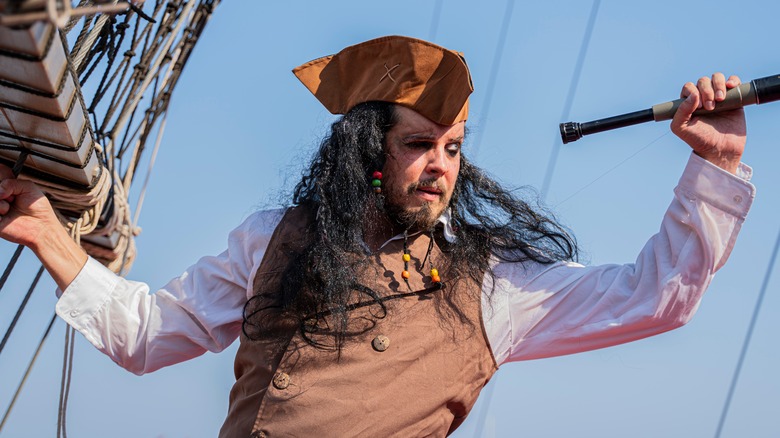Did Pirate Prisoners Really Have To Walk The Plank?
Much of what you think you know about the pirates of old who roamed the Caribbean seas (and elsewhere) between the 16th and 19th centuries is false, according to CBC kids. Thanks largely to Robert Louis Stevenson's book "Treasure Island" and a slew of 1930s-1940s swashbuckling adventure flicks featuring pirates, our collective consciousness about the way pirates spoke, dressed, and behaved is not based on reality, but on myth for the sake of a compelling story.
One such myth about pirates is the idea that they made their captives walk the plank. As a form of invoking the death penalty against an enemy, making them walk into the ocean (and certain death) definitely has a certain psychological panache. It could be equated to the way that some parents would send a child into the yard to find a switch for the parent to beat them with. And, while pirates were often known for their cruelty, they were also men and women with a job to do, and sometimes, time was of the essence.
Pirates had a job to do
Though popular culture has largely depicted them as adventuring hell-raisers, in fact, pirates were mostly just doing what they could to get by, even if that meant being a seafaring thief. As Britannica notes, sometimes pirates were hired by governments to disrupt the commercial trade of other nations. In other words, pirates were doing a job.
In a practical sense, that meant that going through the theater of making someone walk the plank was a massive time-waster, according to Mental Floss. Usually, when a pirate crew would take over a ship, if they couldn't ransom the captives or force the sailors of the captured ship to join their crew, they'd simply throw them overboard. There was no time for making a show of the deaths of the defeated crew.
That's not to say that walking the plank never happened. But, verified accounts of it are few and far between, and it seems to have been reserved for times when the pirates were bored and there was time for amusement. In one particularly gruesome incident in 1829, a pirate crew made the prisoners of a defeated ship walk the plank, all while blindfolded and with cannonballs tied to them.
Other pirate myths
The myth of walking the plank isn't the only falsehood from piracy that has become a part of popular culture. For example, though pirates could be brutal, they rarely tortured captured sailors, or civilians, for sport (or for any reason for that matter), as Mental Floss notes. And, on the rare occasions when they did employ torture, it was done in the course of extracting information. According to Georgetown University of Continuing Studies, many pirate crews had written codes, detailing how they were to treat civilians and other sailors. Further, there is no written record of any pirate ever having kept a parrot on his shoulder.
According to the Children's Museum of Indianapolis, though, one bit of pirate lore appears to be true: the eye patch. Some pirates did indeed wear them, and for good reason. Wearing an eye patch helped a pirate switch from the bright light of day on the open seas to dark places (such as the holds of a ship) without having to wait for their eyes to adjust, as The Wall Street Journal notes.


